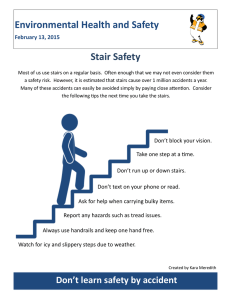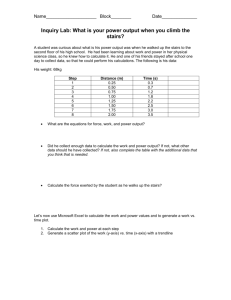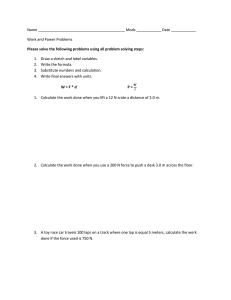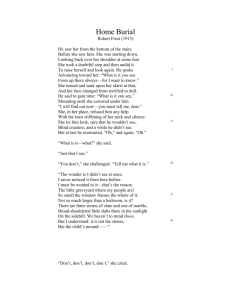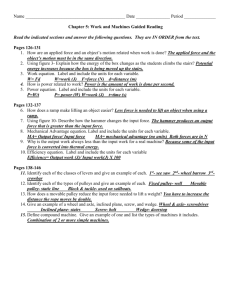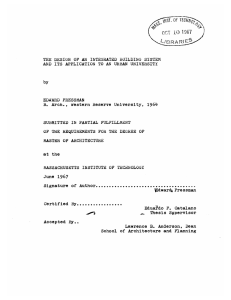6 ~1966 1966
advertisement
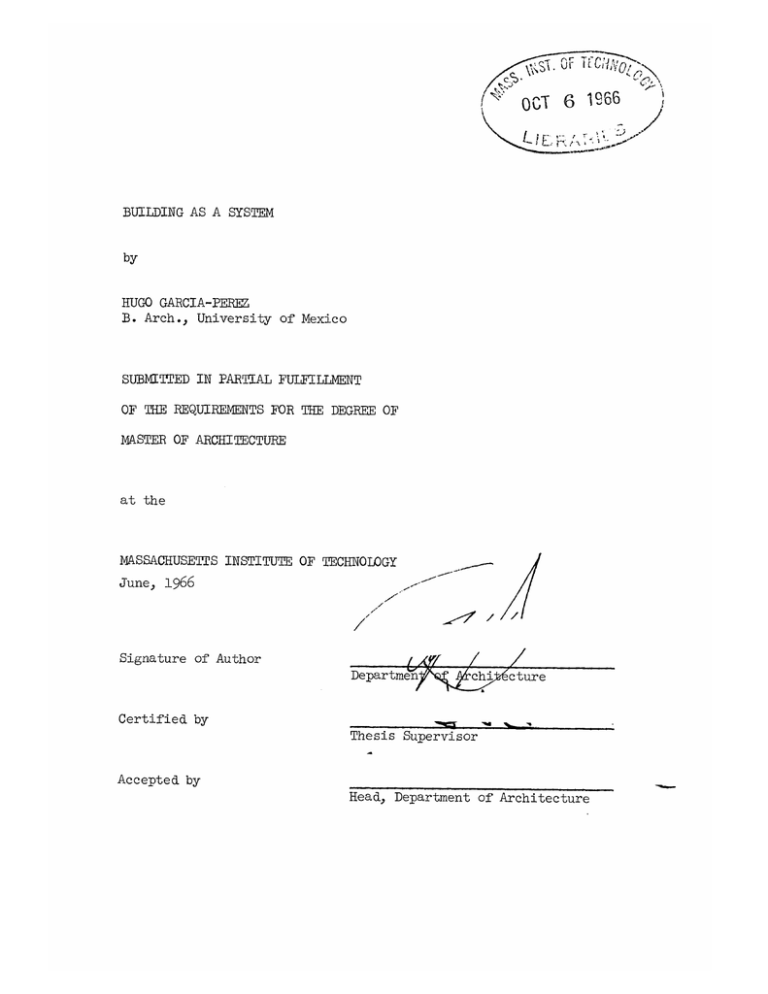
{.OCT
6~1966
BUILDING AS A SYSTEM
by
HUGO GARCIA-PEREZ
B. Arch., University of Mexico
SUBMITTED IN PARTIAL FULFILLMENT
OF THE REQUIREMENTS FOR THE DEGREE OF
MASTER OF ARCHITECTURE
at the
MASSACHUSETTS INSTITUTE OF TECHNOLOGY
June, 1966
IX-
/
/
Signature of Author
Departmen
chi
cture
Certified by
Thesis Supervisor
Accepted by
Head, Department of Architecture
-2-
Lawrence B. Anderson
School of Architecture and Planning
Massachusetts Institute of Technology
Cambridge, Massachusetts
Dear Dean Anderson:
In partial fulfillment of the requirements for the degree of
Master of Architecture, I hereby submit this thesis entitled,
"Building as a System."
Respectfully,
Hugo Garcia-Perez
June, 1966
38
-3-
ACKNOWLEDGEMENTS
I wish to thank
Professor Eduardo F. Catalano, Thesis Supervisor,
and
Professor Waclaw Zalewski, Structures Advisor,
for their guidance to the realization of this thesis.
-4-
TABLE OF CONTENTS
page
TITLE OF THESIS
1
LETIER OF SUBvESSION
2
ACKNOWLEDGEMENTS
3
TABLE OF CONTENTS
4
ABSTRACT
5
FIRST PART
Description of the System Developed
6
The Form Work
8
Assembly
8
Spatial Flexibility
9
Expansion and Removal of Parts
9
The Cores
9
Stairs
13
SECOND PART
Description of Mechanical System
14
Plumbing
15
Lighting
15
Acoustic
16
-5-
ABSTRACT
The aim of this project was to design a footprint of structural, vertical circulation integrated with mechanical components, from which different sizes of buildings, with different spatial qualities, could be
defined and also to achieve possibility of horizontal and vertical
growth.
The central thought in the structural design was to achieve full flexibility in space, simplicity during construction and structural continuity
in both directions.
The idea of applying systems in architecture is to put together all
the components of the building in a unit of design, self sufficient
by itself and achieving perfect control, order and hierarchy in the
final product.
Definition of System - System is an order of things united by some
form of interaction and interdependence of the parts to the whole.
-6-
DESCRIPTION OF THE SYSTEM DEVELOPED
The system developed in this case is a linear system; it was chosen
after a balance of advantages between this and the two directional
system.
The following advantages were achieved in a linear system
over the usual two directional system.
a)
Easy removability of elements to create voids for spatial
flexibility.
b)
No post-tensioning on site (no oversized elements).
c)
No use of scaffolding.
d)
Acoustical control.
The three major advantages of the two directional system over a linear
one were also integrated satisfactorily in the system developed.
a)
The continuity of the structure in both directions.
b)
Flexibility in distribution of mechanical services.
c)
The organization of the inner space (partitions).
The parts of the structural system:
Criterion:
The components of the structural system were developed with
prefabrication, construction and erection process in mind; the final
result is a system with simple structural components and a simple construction and erection process.
The column:
The cruciform shape of the column is due to the fact
that is composed of capital and column cast in one piece.
The size
of the capital is in turn determined by the inflexion points of the
-7-
girder spanning between the columns.
The vertical connection between
the two columns occurs two feet higher than the floor level; it was
done to reduce the shear moment at the connection point.
(See Fig.
#2).
The columns were designed in a flat shape so that they could be mass
produced by casting them horizontally, and pouring one on top of the
other.
The link element:
This is mainly used to transmit the compression
forces due to the transverse continuity of the structure.
The lower
part has two ribs to match the visual aspect of the structure.
The girder:
This element makes connection of the structure in the
main direction and serves to carry the main branches of mechanical
services.
The ends of the girder are shaped so that they can be easily
supported on the correspondingly shaped ends of the capital providing
major area of support.
The slab over the girder:
This element spans between the two beams
of the girder and is an element comparatively less simple than the
rest of the structure.
The shape was designed in a manner to serve
the following functions:
a)
To allow the mechanical services to pass through.
b)
To make welded connection for the reinforcement used to
establish continuity in the secondary direction.
c)
To link the top slabs of the channels.
The channel:
In linear systems, this element is used to cover the
-8-
space between the main axis of the structure; in this case we carry
further on this function by using this element to give structural
continuity in the second direction and making the structure more
economical.
It requires.two structural diaphragms.
They were placed
ten feet from each end and go from the bottom of the channel to six
inches above the lower chord.
The cantilever:
In the main direction the cantilever is achieved
by means of the capital on the columns and an extra element also
used to add half a module to the periphery.
In the secondary direc-
tion the cantilever is achieved by using the continuity of the structure.
The section remains the same, i.e., the channels.
THE FORM WORK
As mentioned before, the structural components of the system were
designed with a view to mass production, therefore the whole structure
was thought precast.
The form work would be in metal and all the
casting process would be done in a factory for better results and
maximum control.
The figures in the following pages will show how the
form work was planned.
ASSEMBLY
All the members of the structure will be transported to the site from
the plant and then laid in their proper positions by a crane.
Each
-9-
element is supported by the previous one, therefore scaffolding is
not required except1 in a cantilever condition.
(See construction
sequence in photos.)
SPATIAL FLEXIBILITY
The possibilities of spatial arrangements in
this case are fairly numerous,
with more emphasis in the main direction of the structure.
In the secon-
dary direction this flexibility is restricted by the variation in the
size of the structural members used as a cantilevering element and by
the main axis of the structure (as girders and columns).
EXPANSION AND REMOVAL OF PARTS
The system was designed in such a way as to allow the easy removability
of any of the structural elements without interfering with the distribution of the mechanical services.
Each bay has been designed as a
self-sufficient unit, structurally and mechanically.
The expansion
of the system must be done in units of one bay each of 35 x 65 feet.
The peripheral services can early be changed into interior services.
THE CORES
The core is an element which serves the following functions:
a)
Provide means of vertical circulation.
-10-
b)
Create a pattern of horizontal circulation.
c)
Create places of meeting around it.
Its sizes and characteristics are defined by its location within the
building.
Following this thought, the cores were designed as a system
of growth with interchangeable elements; the elements to make by a
particular core being chosen to serve definite functions.
The growth
of cores takes place in the main direction of the system.
Each element
of the core was designed as an independent element in itself and based
on a five foot module.
A ten foot wide circulation space surrounds
each core so as to provide maximum flexibility of approach.
The core elements were grouped in two categories
a)
The basic elements.
b)
The complementary elements.
The basic elements are:
1)
Passenger elevator
2)
Fire stairs
3)
Toilets
single
scissors
men
women
The complementary elements are:
4)
Freight elevator
5)
Closets
6)
Public telephones and drinking fountains.
janitor
electric
telephones
Table #1 shows that with just six elements it is possible to get
-11-
forty-eight different combinations of cores, and still these elements
could in turn be varied in themselves.
It shows the tremendous flexibility
and variety achieved designing cores with this system.
COMPILEMENTARY
BASICS
D
E
G
DE
DG
EG
DEG
A
AD
AE
AG
ADE
ADG
AEG
ADEG
AB
ABD
ABE
ABG
ABDE
ABDG
ABEG
ABDEG
ABC
ABCD
ABCE
ABCG
ABCDE
ABCDG
ABCEG
ABCDEG
B
BD
BE
BG
BDE
BDG
BEG
ADEG
BC
BCD
BCE
BCG
BCDE
BCDG
BCEG
BCDEG
C
CD
CE
CG
CDE
CDG
CEG
CDEG
TABLE
#1
DIFFERENT ARRANGEMENTS OF CORE ELEMENTS
H
I\J
-13-
STAIRS
Fire stairs:
The design and location of fire stairs for this type of
building were determined by the building code, which specified 175 feet
(system with sprinkles) as the maximum distance between the farthest
point of the building and a fire stair (along the path of circulation).
Also it specifies an alternative means of escape for every space in the
building.
Scissor stairs were chosen in this case to increase the
service and efficiency without increasing the area.
Open stairs:
Because of the flexibility achieved in this system,
there exists the possibility of placing open stairs in any position
wanted or required.
in the building.
They should be placed where main activities occur
This will help reduce the number of stops for the
elevators, as people will use stairs for short runs.
The stairs also
provide points of recognition because open spaces and perspectives.
Their size will depend upon their importance and amount of activity.
SECOND PART
DESCRIPTION OF MECHANICAL SYSTEM
The system adopted covers a variety of conditions and offers complete
flexibility.
The main distribtuion comes from mechanical rooms through
horizontal bridges, connecting columns which carry the vertical distribution.
The secondary branches of horizontal distribution are lo-
cated in between main girders; and modular distribution in the space
created between two channels every five feet.
(See Board
#3).
In
case there are two adjacent rooms, one needs more volume of air than
the other, the problem will be solved with a special connector above
The main return air system is located in the same
the partition.
places as the supply, but in alternate columns and girders; the modular
distribution for return air occurs in all spaces created between the
channels.
Type of System:
high velocity
feet each.
The type of air supply system adopted is dual duct
(4000
f.p.m.) with mixing boxes serving a bay of 35 x 50
The speed in the secondary branches is reduced to 1500
f.p.m. and 900 f.p.m. in modular distribution branches.
return system is low velocity (1200 f.p.m.).
The air
The fifteen foot width
along periphery is controlled by a mixing box which serves a bay of
15 x 70 feet.
Air Diffusers:
These are located within the structure along the
-15-
space created. by joining two channels every five feet.
In the periphery
zone air diffusers are located either in the ceiling or window wall
for supply.
Return grids are placed in the ceiling.
PLUMBING
The plumbing system is divided into two groups:
a)
The toilets and mechanical rooms.
b)
Extra pipes of secondary services.
The first ones are located in the cores and shafts and the secondary
but general service in the columns.
Each pipe group in a column serves
a bay of 35' x 125' and is composed of
a)
Water supply, hot and cold.
b)
Waste.
c)
Vent pipes.
Waste and vent horizontal runs are provided with a scope of one inch
to a foot.
LIGHTING
The lighting system is located within the channels.
The variation of
foot candle intensity will be given by the type of space to be illuminated.
The range achieved is:
66 F.C. with 1/40 watt lamp
-16-
132 F.C. with 2/40 watt lamps
198 F . C . with 3/40 watt lamps
The type of lamps to be used are fluorescent tubes, 40 W,, nine feet
long to match with the rectangular module of the structure and for
economy.
ACOUSTIC
The structure was designed without perforations to eliminate problems
of sound transmission.
In the secondary direction whenever a partition
occurs, a contact diaphragm will be placed.
As a general treatment,
an acoustical panel shall be placed at the bottom of the channels.
The same acoustical panel serves to cover electrical wires and pipes
wherever they occur.
i
S0
V
i
V
S
V
0
I
0
1
I
flA
,
g
A
IB
e
Xim
I
_____________~~~~~
LIL
I_____________
~I I
il
ol
L
Elu
W
3
.L
S
A
s
IS
Yv
TI
I
_
_
_
I
0
N
I
0
1
I
_________
I
f
9
._._._._._._.
IT
I
_ _
.. . ....U
__
_
_
_
rU1l!1
_
1lT!1~
1t1
M
11MIl
1 1r1 11i
I
I
3
N
1
I
a
s
A
I
d
s
0
0
v
v
w
0 ;
i S A S V SI V
a
If
d
-4.n
T
Alddne e a
A ddne
111 1 1 1 1 1I1HI
11 1
Ili;i
11,111H
e---------------e-------e-------e- ----
a
-
e
a
-
n-
a
7i4ad
1i
I
...... M illi lill
............
............
.. . ........
I I
aa a a a a
aa.a..n...n..n..n..a..a..a
8. 1
1
I
1 . .
111LIM
IL
0. i I , .
i
.,
e
. , ..
a
. ,
a
.
c
W
%
6
8
3
1
0
H
u !u
u
u
S
:1
d
a
* d o
u
A
S
v
S
YV
0
a
1
I
n
g
1
u o d
o
d %
e
1 .
q
|
a
u
.
Ao p
W
3
N,
i
S
A
'4
0
,
S
41
0
S
Y
0
N
I
0
1
A
I
0
u 0
4
J
Y
4
u 0
0
,0
I
44
15
n
0
4
LOW
1
I
I
i1
I1
5
W
ii
0v
0
!
0
w S
A
a
S
aeeeV
S
V
0
N
I
0
l
I
A
a
0
-V
u14
0s
u0
1JI
,0
,v
a
C
.0
v m 01 A3
02
l
u00
1
J0
+
9
w
3
1
S
A
s
W
~S
SY
S
V
..
N
0
i...l
....
Il
LILI
co
61
z
W
v N a1 a I. S - v A. . ....
1
0
u v 0
V
S~
4 3
1
'I
V
10
1
m0
4
C
N
I
U
1I
I
fl
9
2 0
JOTrzt--,\
|
a
I
d
0
!
u
0
4
r
-
L
I
F]
~1L
1
L
uo
a
1
pa p
i
d
i
1
tl- --
~r~4
U 0
!
f
0
A
I1
0
9
4
A
L
I-j
I
I
a
K
V
ii
I
I
U
I
U
at
I
I
t
